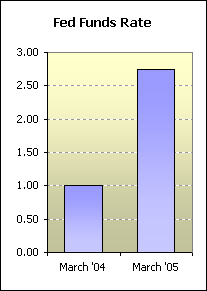|
1st Quarter 2005 |
Stress-Testing for Interest Rate Risk
|
||||
|
|
In the summer of 2003 we had an opportunity to back-test or validate the A/L
BENCHMARKS interest rate risk peer data. Between June 2002 and June 2003
treasury yield rates dropped an average of -100bp. At that time we examined
the net interest earnings at risk data to see how accurately the A/L
Benchmarks model predicted the behavior of banks’ net interest income. The results then were compelling
with the model predicting that 54% of banks would experience a drop in
margin compared to 51% of banks that actually saw margin decline.
the behavior of banks’ net interest income. The results then were compelling
with the model predicting that 54% of banks would experience a drop in
margin compared to 51% of banks that actually saw margin decline.
The first quarter 2005 data offers us a similar circumstance to back-test the interest rate risk peer information. Since June 2004 the Fed has raised its target fed funds rate seven times from 1.00 to 2.75 as of March 2005. Shorter-term treasury yields and prime have also risen substantially since last summer. Despite the fact that long-term treasury yields have remained unusually low, most banks are experiencing the impacts of a generally rising rate environment. The model’s test To get an idea of how banks will react to a rising (or falling) interest rate environment the A/L BENCHMARKS model performs a stress-test. It measures the potential change to net interest income given a shift in interest rates both up and down. To measure a bank’s exposure the model uses an industry standard +/-200bp shock to market rates. While A/L BENCHMARKS is capable of performing rate ramps, yield curve twists, and non-parallel shifts, we use +/-200bp for peer analysis to maintain consistency from quarter to quarter and consistency with the industry.
Actual performance vs. Model Results The latest Quarterly Banking Profile from the FDIC (March 2005) reports that rising interest rates have for the most part hurt banks’ net interest margin. “Margins Fall as Interest Rates Rise…funding costs rose more rapidly than asset yields during the quarter, causing net interest margins to decline…the industry’s net interest margin in the first quarter was the lowest registered in almost 15 years.” The A/L BENCHMARKS peer data from March 2004 showed that 53% of banks could experience a decline in net interest margin due to rising market rates. One year later the data shows that 44% actually saw their margin decline. The March 2004 data also predicted the magnitude of change. For those banks at risk to rising rates the model projected a drop in average margin of -30 basis points. One year later the data shows that of the 44% whose margin declined, the average decrease was -24 basis points. Is the test accurate?
The results of the interest rate risk stress test from one year ago seem to be consistent with actual industry performance. There are obviously differences, but it is important to keep in mind that this is a stress-test, not an exercise in predicting reality. For example, a stress test assumes that the changes in interest rates occur instantaneously, while in reality, they occur in steps over the course of the year. Stress testing is designed to highlight certain exposures or the potential for loss in the bank, not to determine the exact day on which earnings will decline. Over the course of the year bank management will adapt to the changing rate environment. Some of these adjustments can be captured in the model because they are clearly anticipated; others cannot. Also, the forecast of interest rate changes is not an exact science. While short-term rates rose by +175 basis points, long rates did not. In fact, just about any prediction of interest rates is likely to be faulty, but we need to choose a change that will provide a good stress-test; a test that can tell us in general what to expect under certain conditions. Will a bank’s margin tend to increase as interest rates rise? Or is the bank’s margin at-risk to rising rates? It appears the Fed may still raise rates two or possibly three more times before the end of the year. Many are predicting long rates are finally on their way up. The question is what will happen to your bank’s net interest margin as market rates change? Are your positioned to take advantage of the change? Do you review the
results of an interest rate risk stress test for your bank? Is your stress
test accurately predicting what to expect? If not, you should carefully
review your assumptions and data. A predictive model or stress test
simulation is usually only as good as the data provided. Stress testing
continues to be a valuable source of the risk potential to your bank.□
|
||||||||||||||||
|
This
A/L BENCHMARKS Industry Report article was published |
||||||||||||||||